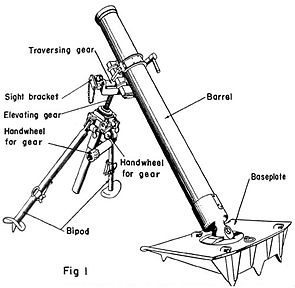10 cm fog thrower 35
| 10 cm fog thrower 35 | |
|---|---|
| General Information | |
| Military designation: | 10 cm fog thrower 35 |
| Manufacturer country: | German Empire |
| Developer / Manufacturer: | Rheinmetall |
| Development year: | 1934-1935 |
| Production time: | 1935 to 1941 |
| Weapon Category: | Grenade launcher |
| Team: | 7 men |
| Technical specifications | |
| Pipe length: | 1,344 m |
| Caliber : |
10.5 cm |
| Caliber length : | L / 13 |
| Cadence : | 10 to 15 rounds / min |
| Elevation range: | 45 ° - 90 ° degrees |
| Side straightening area: | 28 ° |
The 10 cm Nebelwerfer 35 ( 10 cm Nb.W.35 ) was a heavy grenade launcher that was used by the German Wehrmacht during the Second World War . It was the main weapon of the Nebeltruppe at the beginning of the war and was used in so-called fog departments .
Similar to the American " 4.2-inch Chemical Mortar M2 ", it was intended to fire chemical ammunition such as smoke and gas grenades . In contrast to the American model, the Nb.W.35 also had a conventional explosive projectile from the start. The Nb.W.35 was a conventional design and was basically a modified 8 cm grenade launcher 34 .
Operation and transport
The Nb.W.35 was dismantled into three partial loads for transport, of which the tube weighed 31.7 kg, the base plate 36.3 kg and the bipod 32.2 kg. The gun crew consisted of the gun leader , three gunner and loader and three ammunition carriers.
Stand for transport in the area after getting off the motor vehicle
- the "Nebelfahrzeug 1" (Nbf.1), the "Throwing cart for 10 cm fog throwers", and
- the "fog vehicle 1/1" (Nbf.1 / 1), the "ammunition cart for 10 cm fog throwers",
to disposal. Both handcarts were collapsible and were loaded onto the vehicles for the march.
These two carts were later replaced by the "Nebelfahrzeug 2" (Nbf.2), the "handcart for 10 cm fog throwers", which was more simply constructed and could no longer be folded up.
Fog throwers, ammunition, handcarts and service on the Sd.Kfz were used for the march . 11 /1 downloads, the "fog cars with chassis of slight traction carriage 3 tons" verlastet (le.Zgkw.3t.).
Mission history
Like the American “Chemical Mortar” developed around the same time, the NW35 were grouped into departments (cf. battalions) with three batteries each. They were "army troops" and were assigned to the divisions if necessary. All fog departments were basically motorized.
In October 1935 the "Fog Teaching and Experiments Department" and "Fog Departments" 1 and 2 were set up. These were available for the attack on Poland in 1939 . At the beginning of the French campaign , this number had increased to six, including the (renamed) "Fog Teaching Department", by setting up departments 3 to 5. In March 1940, departments 6 to 9 were also set up, so that in 1941 a total of 10 departments were available for the Barbarossa company . In May 1940, the “8. Battery of the artillery regiment 222 “(8./Art.Rgt.222) has been equipped with eight 10 cm Nb.W.35. The battery was later renamed "Nebelwerfer-Batterie 222" (Nb.W.Bttr.222). In January 1942 the "Gebirgs-Werfer -teilung 10" with the Nb.W.35 was also set up.
From the end of 1941 the "10 cm Nebelwerfer 35" was replaced by:
- the "10 cm Nebelwerfer 40" (10 cm Nb.W.40), a grenade launcher with a rear loading system ,
- the " 15-cm-Nebelwerfer 41 " (15-cm-Nb.W.41), a rocket launcher and
- the “ 28/32 cm heavy throwing device 40 ” (sWG40).
The "fog departments" were reclassified into "fog throwers departments" and combined in regiments.
The Nb.W.35 were then used by other units as conventional grenade launchers.
ammunition
The launcher fired
- the 7.26 kg high explosive grenade (10 cm Wgr.35 Spr), which carried 1.7 kg TNT,
- the 7.26 kg heavy smoke grenade (10 cm Wgr.35 Nb), which carried 1.7 kg FS,
- the warfare grenade (10 cm Wgr.35 Kh) [chamber case], which was filled with yellow cross,
- the (little produced) warfare grenade (10 cm Wgr.35 ZB) [intermediate floor], which was filled with 0.9 kg warfare agent, and
- the 7.35 kg heavy, 432 mm long throw grenade 37 (Wgr.37 Spr), which carried 1.28 kg of explosives.
Fired with a base charge of 15 g and four propellant charges of 21 g each, they achieved a muzzle velocity of 193 m / s and a range of 3025 m. The spread was 65 m.
literature
- Barker, AJ: The German Infantry Weapons of the Second World War . Motorbuch Verlag Stuttgart, 2nd edition 1975, ISBN 3-87943-328-3 .
- Terry Gander, Peter Chamberlain: Encyclopedia of German Weapons 1939-1945 . Motorbuchverlag, Stuttgart 2008, ISBN 978-3-613-02481-6 .
- Hahn, Fritz: Weapons and Secret Weapons of the German Army 1939–1945, Volume 1 . 3. Edition. Bernard & Graefe Verlag, Bonn 1998, ISBN 3-7637-5915-8 .
Individual evidence
- ↑ Kfz. of the Wehrmacht, Nbf.1 / 1 and Nbf.1 / 1
- ↑ Kfz. of the Wehrmacht, Nbf. 2
- ↑ Sd. Vehicle 11/1 Nebelkraftwagen ( Memento from June 30, 2013 in the Internet Archive ) Kfz. of the Wehrmacht, Sd.Kfz.11 / 1 Nebelkraftwagen
- ↑ Army Nebelwerfer Units ( Memento from February 6, 2009 in the Internet Archive )
- ↑ Terry Gander, Peter Chamberlain: Encyclopedia of German Weapons 1939-1945 . Motorbuchverlag, Stuttgart 2008
- ↑ a b c Barker, p. 74
- ↑ a b Hahn, p. 81
- ↑ Hahn, p. 70
- ↑ Hahn, p. 70.
